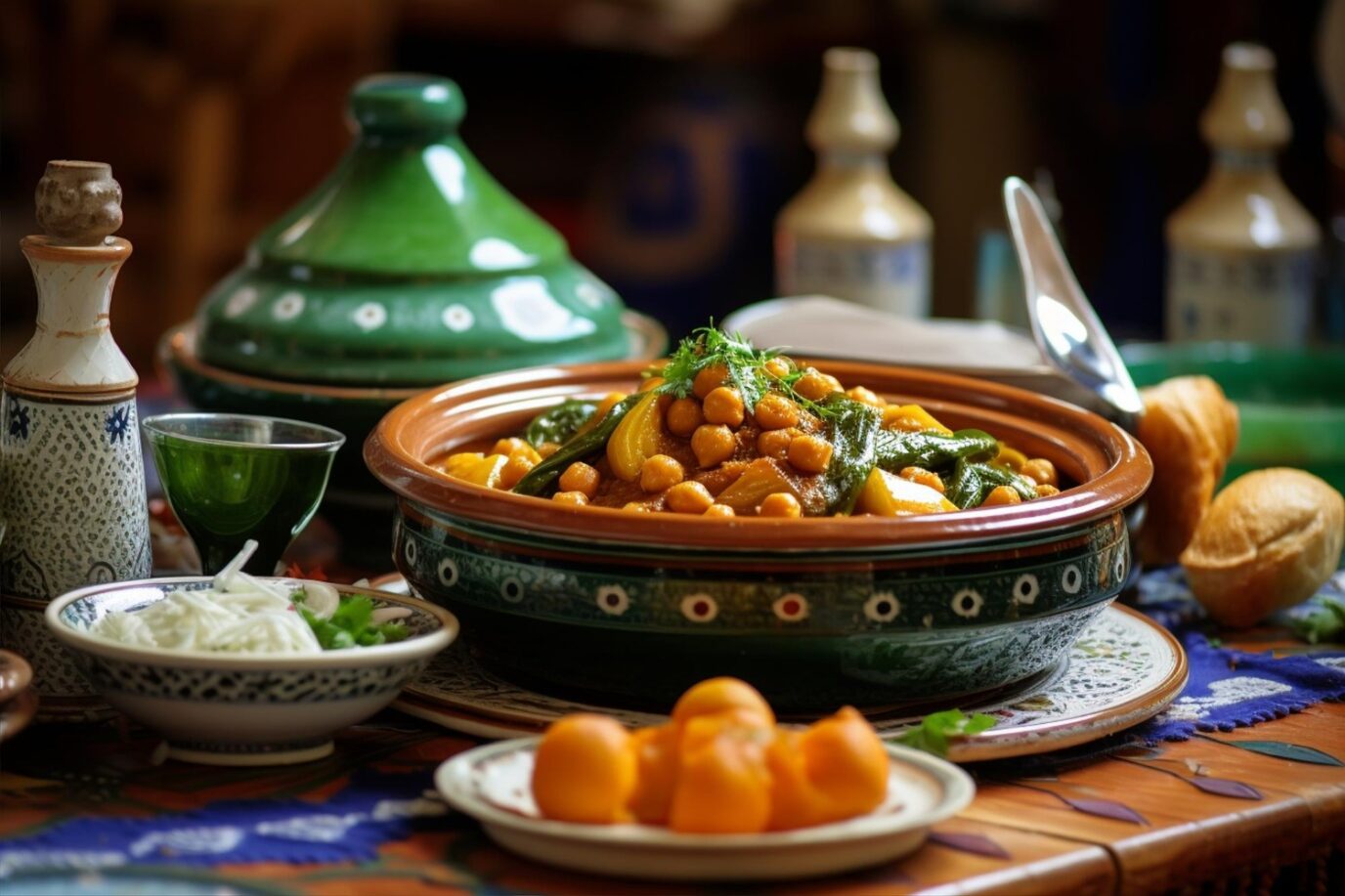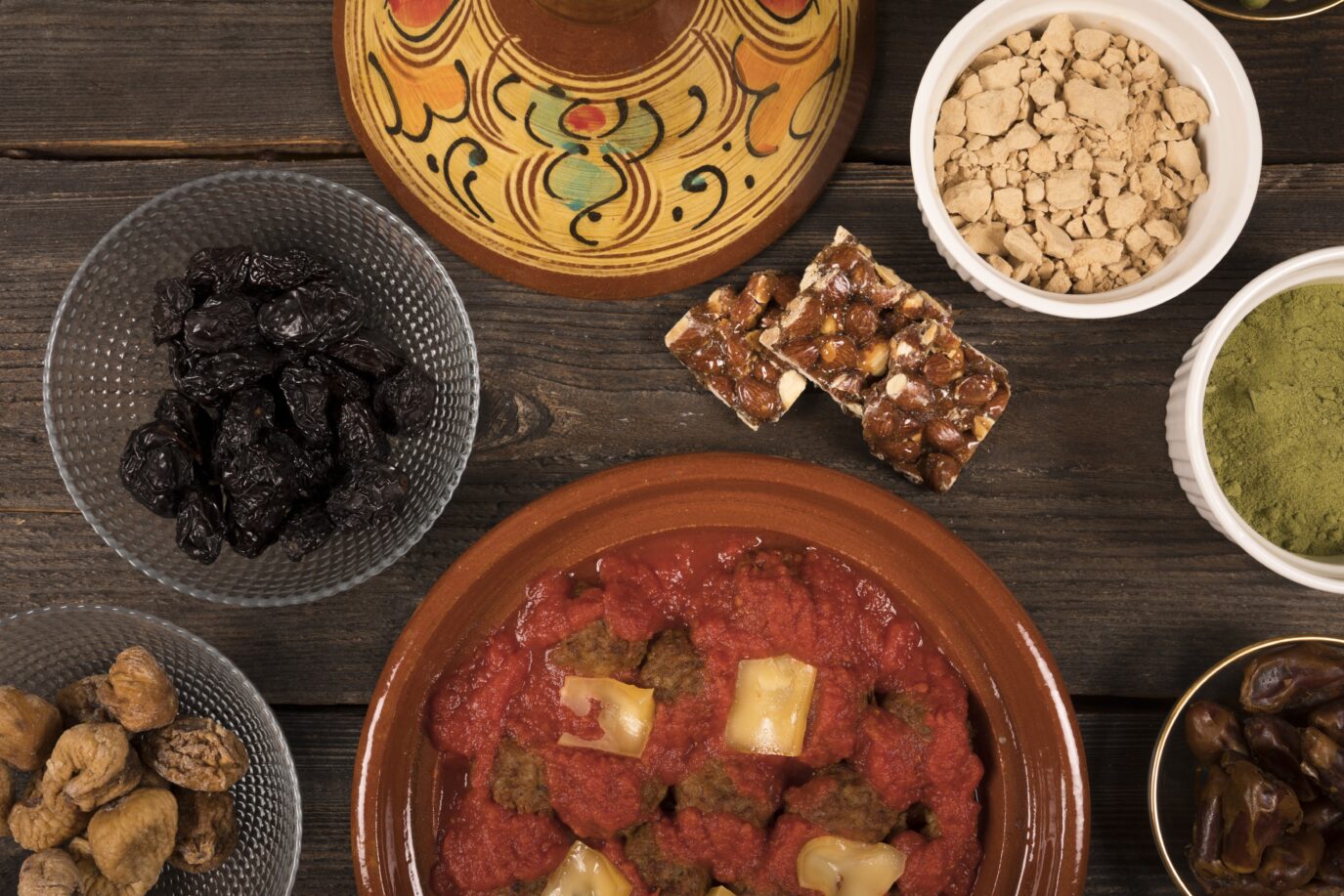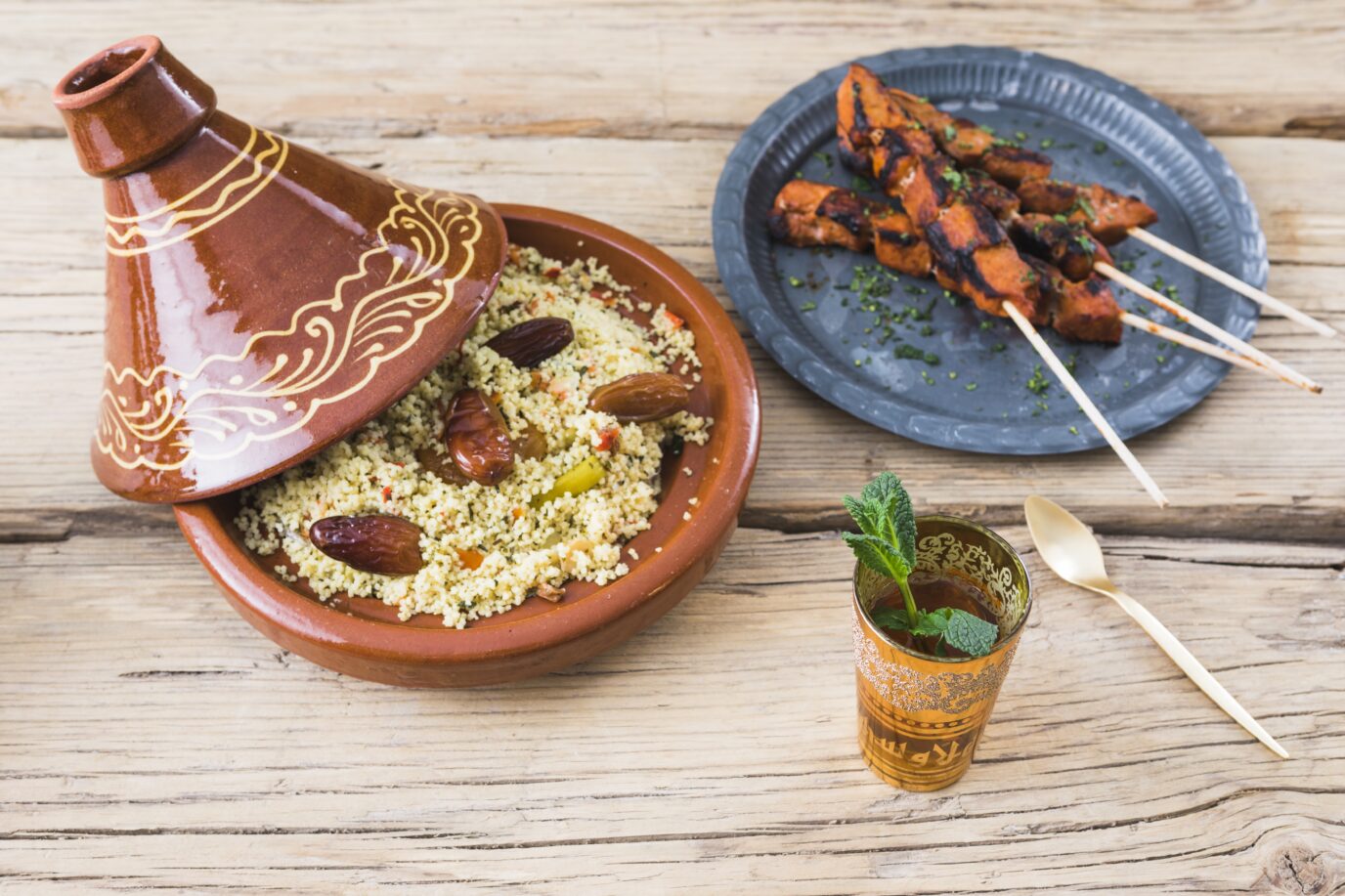Moroccan cuisine, in itself, is an excellent reason to visit the country. If you enjoy trying new flavors and different dishes, the culinary offerings you will find in Morocco will not disappoint you. Additionally, Moroccan cuisine is highly diverse, with each region offering its own unique recipes worth exploring. Renowned for its distinctive flavors, often derived from spices and condiments unfamiliar to Western palates, as well as its sweet undertones that leave you craving more, Moroccan cuisine offers a rich cultural experience. Therefore, if you wish to delve into the culinary traditions of Morocco, pay close attention to all the insights we provide here.
Tradition and history of Moroccan cuisine
Moroccan cuisine is vibrant and diverse because its influences are too. One of the most present traditions in Arabic, which is why it shares many dishes with other countries in North Africa and the Middle East, although with its own local version.
However, Moroccan cuisine is much more than that. Because the Ottoman Empire never ruled over this region, unlike other Maghrebi cuisines, it has little or no Turkish influence.
In addition, another characteristic feature is the powerful Amazigh influence, which occurs in practically all cultural aspects of the country. A good part of Moroccan cuisine was conceived in the 14th century, in the times of the Marinid dynasty, and more specifically in its rich palatial kitchens, with recipes and ingredients that reached domestic kitchens.
Andalusian, Sephardic, French, and even Spanish influences can be seen in Moroccan cuisine according to the country’s long history of cultural exchange. All this, together with this Islamic country’s lifestyle, makes breakfast, lunch, and dinner (and even a tea break) an authentic experience that will surprise any traveler for good.
Products and typical dishes of Moroccan gastronomy
There are many dishes and typical products of Moroccan cuisine. And in our blog, by the way, we dedicate many posts to describing each of them in-depth. What’s more, they’re readily available throughout the country, whether in restaurants, popular markets, antique shops, or even in the homes of your hosts. Here we show you some ingredients, dishes, and sweets that make Moroccan cuisine one of the most special in Africa and the world.
Moroccan cuisine ingredients
The dishes included in the following section are actually the result of the combination of many elements. On the one hand, the ingredients and products, and on the other hand, the utensils and presentation equipment that you can practically only find here.
Ingredients
As for the ingredients, spices and seasonings deserve special mention. Ras el hanout is a blend of several distinctive spices, each with its own composition (store, brand, restaurant, etc.)… and it always remains a secret. However, we can mention the following, whether in the ras el hanout or used as an independent ingredient: paprika (hot and sweet), ginger, turmeric, cumin, saffron, nutmeg… and many more that you can find in this post.
Vegetables and fruits
Vegetables and fruits also play a vital role in Moroccan cuisine: eggplant, tomatoes, lettuce, onions, and olives are classics of Mediterranean cuisine, which have left their mark on the country’s cuisine. But we can also mention other, more “exotic” suggestions, such as dried fruits, dates, argan, etc.
Meats
As for meats, everything is primarily determined according to the specific Islamic rules regarding halal food. In other words, pigs and birds of prey are prohibited. All animals used for food must adhere to specific sacrifice rituals, highlighting all the obligations related to this in the face of Mecca. This means that the main meats are lamb and poultry, such as chicken and turkey. Beef is allowed although it is less common than those mentioned. Similarly, eggs are widely used in Moroccan cuisine.
Fish
Thanks to the vast expanse of Moroccan coasts, it is easy to find fish and shellfish in traditional Moroccan cuisine. However, they are mainly limited to coastal areas because it is very hot inland. It was difficult to keep them alive and transport them in the past. Among the emblematic species of Moroccan fishing are sardines, royal dorado, and sole.
Grains
Grains also have a strong presence in Moroccan cuisine, bread is sacred, and its main version can be compared to pita bread. But there are many others: m’kella, batbout… and of course, we cannot forget couscous, which is wheat semolina in the form of small balls, and which is actually the basis for many dishes with different ingredients.
Famous Moroccan cuisine
With the ingredients mentioned in the previous section, and with many more that populate its markets, Moroccan food will surprise you with dishes as iconic as the following:
- Tagíne: a kind of stew that, in fact, admits practically any ingredient… as long as it is cooked and served in its characteristic clay pot with a conical lid. Chicken, beef, lamb, fish, dates, raisins, apples, olives, almonds, eggs…
- Couscous: as we said, it is wheat semolina in the form of small balls, but numerous dishes with that name are made on that basis. They can have meat, for example, lamb, but what they provide the most richness are vegetables and legumes (pumpkin, courgettes, carrots, cabbage, turnips, chickpeas, etc.), fruits and honey for a sweet touch, and spices to achieve many other nuances
- Amazigh pizza: this is a ubiquitous dish in the south of the country, in the Sahara desert, as it is a traditional preparation among nomads and inhabitants of the far south
- Pigeon pastilla or bastela: this is one of the most popular dishes, and its name refers to the way it is prepared (a pastry pastille), stuffed with chicken (or other birds, such as pigeons, hence its name) ), almonds and onion, where the sweet touch is provided by cinnamon and sprinkled icing sugar
- Bissara: it is a puree of broad beans, simple and humble but deeply rooted in Moroccan gastronomy
- Harira: it is a traditional soup that, in addition to adding noodles, offers rich chunks, mainly of meat, tomatoes, and different legumes such as lentils or chickpeas
Popular sweets in Morocco
Popular sweets are not as varied as the savory dishes of Moroccan cuisine. But in reality, there are sweet pastry proposals in every corner of the country that you should take advantage of during your trip. Some of them are ‘national’ and, in fact, are taken at very representative times, such as iftar (the time when the daily fast during Ramadan is ended).
This is the case with chebakia , a sweet made from flour, egg, butter, toasted almonds, sesame, honey, and other flavored ingredients. The sfenzh is also used to break the fast, but this time it means “breakfast” as the day’s first meal. Briwat is triangle-shaped pastries filled with empanadas, usually served as a ‘snack’ on special occasions, such as banquets. Also, couscous has its own sweet version, known as seffa .
Unique utensils of the Moroccan cuisine
Another exciting aspect linked to Moroccan cuisine is the utensils used to prepare the dishes and sweets indicated above. Some are made for a specific word, like the couscous pot used to steam couscous or the clay pots with conical lids used for tagines. These are used to keep the heat and moisture in food that has already been cooked and served.
In fact, clay is a material widely used in Moroccan kitchen trousseau, as is also shown by the tangia for the preparation of slow-cooked stews and soups. You can walk around a kitchen or a shop where utensils are sold. In that case, you will discover other elements, often made of copper, that are very suggestive.
Typical drinks of Moroccan gastronomy
Drinks represent a fundamental element of Moroccan cuisine. Some describe a valid symbol of Moroccan culture, such as tea, which can even be drunk five or six times a day. The so-called Moorish tea, a green tea with mint, is the most widespread. It can be taken at any time and helps combat dehydration in a hot climate. However, it also represents a social and hospitality act.
A particularity of the typical drinks of Morocco is the absence of alcohol, as the Koran clearly specifies. However, small wine productions in places like Meknes or fig liqueurs originate in the Sephardic culture. On the other hand, fruit juices are trendy, especially orange juice. And milk-based beverages have achieved great variety and popularity in recent times. In this sense, one can cite sour milk (scented with honey and thyme).
This is a typical food in Morocco
Usually, the most important meal of the day in Morocco is at noon. In the holy month of Ramadan, when fasting is mandated, this meal is moved to the evening, known as iftar, where it is served at sunset. During a trip, the daily rhythm differs, affecting what you eat. For example, to make the most of the day, your main meals may be breakfast and dinner, and lunch may be a snack to give you energy for the rest of the day’s activities. In our circuits, it is typical for breakfast and dinner to be included in the package, except in large cities where the traveler is left with more choices.
The typical Moroccan lunch usually starts with a salad, a healthy way to open your mouth. Then comes the main course, which is generally one of the many tagines typical of Moroccan cuisine. And to conclude, a dessert is usually offered as seasonal fruit or a sweet, with popular ingredients such as almond paste and white sugar. In addition, tea is provided to all diners at some time throughout the meal, especially in the middle.
This is a typical banquet in Morocco
The culinary proposals listed on this page about Moroccan cuisine are tasted daily and on special occasions. In fact, a characteristic feature of this country is the usual celebration of banquets. They can be organized for exceptional events, such as wedding receptions, and to strengthen family ties. During Eid al-Fitr, the final day of Ramadan, the iftar, the meal with which the daily fast of Ramadan is broken, is another notable occasion to have a banquet.
And what is usually eaten at a typical Moroccan banquet? Well, everything, and in generous portions, on plates arranged all over the table, which in this case usually has a lower height than usual. The first great dish to arrive is the typical Moroccan bastela or empanada, which is not generally missing on these occasions. Tajines of different types and other versions of couscous are also served. And to give more solemnity to the banquet, the dishes can be flavored with various herbs and spices and sprinkled with sesame seeds and toasted almonds. Fruit is also very present, especially on ice and in large bowls. This is done with a formal tea ceremony to show how important the meeting is.
Frequently Asked Questions
What is traditional Moroccan food?
Moroccan traditional food is known for having a lot of different sauces and fragrant ingredients. Tagine, a stew simmered with meat or vegetables, and couscous, which is often served with meat or veggies in a tasty broth, are two of the most well-known dishes. People usually eat sweet dates with harira, a filling soup made of lentils, tomatoes, beef, and beans. Pastilla is a savory pie made of layers of dough, chicken, nuts, and eggs. Powdered sugar and cinnamon are sprinkled on top. When you roast koftas, which are spicy meatballs, they usually come with tomato sauce. Last but not least, fresh mint leaves and sugar are used to make the famous Moroccan mint tea. Bold flavors and fresh, locally grown products make the food unique.
What is the most traditional food in Morocco?
One of the most famous meals in Morocco is couscous, which has been a part of Moroccan food for thousands of years. A lot of Moroccans think of it as their national dish. When you boil semolina wheat, it turns into small, fluffy grains. Couscous is usually served with a meat or veggie stew with turmeric, coriander, and cumin. The stew is on the rice to make a hearty and filling meal. In Morocco, couscous is traditionally eaten on Fridays, the Muslim holy day. It is also commonly served at special occasions like weddings.
Why is Moroccan food so good?
Moroccan food is famous for using a lot of different spices to make tastes that are all their own. Fresh herbs and common spices like cumin, paprika, ginger, and saffron make food taste better. Local ingredients like fruits, veggies, and proteins add natural flavors. Moroccan food has a lot of different tastes because it is influenced by Arab, Amazigh, African, and European cultures. Slow cooking methods, such as stewing and braising, let tastes blend over time, making both tasty and filling meals. Moroccan food is authentic because it is made with spices, fresh ingredients, different inspirations, and tried-and-true cooking methods passed down from generation to generation.









